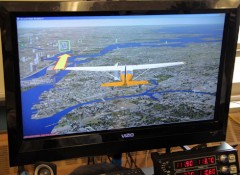Grade Level
9 -10
minutes
15 minutes or fewer
subject
Engineering and Tech
Activity Type:
flight simulation, technology
“Now he has to try to land without hitting the GW Bridge; here comes the GW Bridge in front of him…Straighten out! Straighten out! Don’t hit the GW Bridge! Save the passengers!”
That’s what one 9th grader heard as he tried to pilot his passengers to safety aboard US Airways Flight 1549. It was a dramatic end to a January morning spent with Mr. Henry Rey’s aeronautics class at Frederick Douglass Academy in New York City.
For several hours, I had been watching teens like this one using flight simulation software to pilot commercial airliners over Manhattan and Queens. (If US Airways Flight 1549 rings a bell, that’s the one that Captain Chesley Sullenberger landed safely on the Hudson River after a flock of geese impaired its engines.) The students were divided into pairs: One monitored the radio, speed, and orientation of his or her aircraft, while the other provided guidance on how best to craft a descent into LaGuardia National Airport.
Each simulator setup consists of a large monitor display of a cockpit and a pilot’s chair seated in front of a radio console, alongside a throttle, yoke, and rudder. The simulators were running Prepar3D, an open flight simulation software package used to train commercial and military pilots and created by defense contractor giant Lockheed Martin.

No part of this class is tied to the U.S. Military, or to commercial airlines like Delta, Southwest, or United Airlines. Instead, the students were completing flight missions as part of a unit on atmospheric layers and weather. Students had recently finished a study of how pressure and temperature change with altitude, and how those conditions relate to the ideal cruising altitudes and flight paths of various aircraft.
Most of the topics addressed in Mr. Rey’s class are routine in physical science and algebra classes, and could be taught without fancy flight simulators. But time spent on the devices reinforces certain lessons and also adds a fun incentive for completing assignments in a largely self-paced classroom. As students complete work and become more accomplished pilots, they get to design missions for novice peers and try their hand at piloting famously perilous flights of years past, like US Airways Flight 1549. Mr. Rey uses this innovative combination of STEM content and flight school to target students who are on track to graduate, but who haven’t been bitten by the STEM bug.
It’s unusual for a public school to offer a STEM program rolled into a flight course. Most schools don’t have teachers who moonlight as flight instructors, and finding administrative and financial support to train teachers in the simulation software poses a challenge. The cost of the simulators alone can present a significant barrier, with different models costing between $3,000 and $5,000 apiece.
At Frederick Douglass Academy, simulators were provided for free by HotSeat Chassis Inc., the company that makes them. Its CEO, Jay Leboff, has been marketing the simulators to other schools and districts for use as STEM labs or for afterschool flight clubs.
Rey and Leboff are collaboratively developing a curriculum that incorporates the simulators into instruction aligned with the Common Core and Next Generation Science Standards. Rey, however, was quick to point out that the benefits of flight training in the classroom extend beyond pure STEM knowledge. “Basically, this is a confidence builder,” he said. “Many of the students say, ‘Oh, I can’t do that.’ Then we say, ‘Yes, you can, and we’ll prove it to you.”
Related Links
Meet the Writer
About Ariel Zych
@arieloquentAriel Zych was Science Friday’s director of audience. She is a former teacher and scientist who spends her free time making food, watching arthropods, and being outside.
